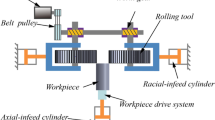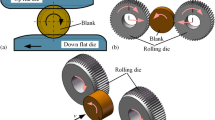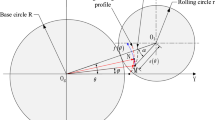Abstract
Working tooth depth is the key factor of affecting the transmission of motion and power for gear pair, which is closely related to the tooth depth of gear. To reveal the growth law of the formed teeth in the cylindrical gear rolling process with axial infeed, a sliding ratio model and contact stress model between tooth profiles of rolling die and workpiece were firstly derived based on the characteristics of the gear pair and rolling process with axial infeed. Rolling of cylindrical gears with module of 1.75 mm and pressure angle of 20° was then taken as an example to verify the above-mentioned models, and the influence of the working pressure angle, number of teeth of workpiece, and rotational speed of rolling dies on the effective tooth depth of the workpiece were analyzed by using finite element simulations (FES) and experiments. The results show that the effective tooth depth of the formed workpiece increases with the increases of the addendum modification coefficient of the rolling dies, number of teeth of the workpiece, and rotational speed of the rolling dies. The sliding ratio and contact stress decrease with the increases of the addendum modification coefficient of the rolling dies and number of teeth of the workpiece. Moreover, the effective tooth depth of the workpiece formed by the rolling dies with addendum modification coefficient of 1 is increased by 7.41% compared to that formed by the rolling dies with addendum modification coefficient of the 0.













Similar content being viewed by others
Data availability
The authors declared that the data and material are available.
Abbreviations
- v t1 :
-
Tangential velocity of the rolling dies
- v t2 :
-
Tangential velocity of the workpiece
- v 21 :
-
Relative sliding velocity of the rolling dies and workpiece
- w 1 :
-
Angular velocity of the rolling dies
- w 2 :
-
Angular velocity of the workpiece
- r Q1 :
-
Distance between point Q and o1
- r Q2 :
-
Distance between point Q and o2
- α Q1 :
-
Pressure angle of the circle where point Q is located on the rolling dies
- α Q2 :
-
Pressure angle of the circle where point Q is located on the workpiece
- η 2 :
-
Sliding ratio of the formed tooth profile
- η 2t :
-
Sliding ratio of the formed tooth top
- r b2 :
-
Base radius of the workpiece
- r 0 :
-
Initial radius of the workpiece
- α :
-
Pressure angle of the pitch circle
- α′ :
-
Working pressure angle
- α B2 :
-
Pressure angle of the circle where point B2 is located
- z 1 :
-
Number of teeth of the rolling dies
- z 2 :
-
Number of teeth of the workpiece
- E :
-
Equivalent modulus of elasticity
- E 1 :
-
Elasticity modulus of material of the rolling dies
- E 2 :
-
Elasticity modulus of material of the workpiece
- ρ :
-
Equivalent radius of curvature
- ρ 1 :
-
Curvature radius of teeth of the rolling dies at contact point Q
- ρ 2 :
-
Curvature radius of teeth of the workpiece at contact point Q
- h i :
-
Height increment of the formed teeth
- H i :
-
Effective tooth depth of the workpiece
- F n :
-
Normal force at contact point Q
- F t :
-
Circumferential force at the contact point Q
- s :
-
Standard center distance between the rolling dies and workpiece
- s′ :
-
Actual center distance between the rolling dies and workpiece
- b :
-
Tooth width
- λ :
-
Gear ratio between the rolling dies and workpiece
- x 0 :
-
Abscissa of point o2
- y 0 :
-
Ordinate of point o2
- x ti :
-
Abscissa of point at
- y ti :
-
Ordinate of point at
- φ′:
-
Similar geometric pressure coefficient
- μ :
-
Effective tooth depth coefficient
- m :
-
Module of the workpiece
- n :
-
Number of measurement
- x :
-
Addendum modification coefficient
- h * :
-
Addendum coefficient
- c * :
-
Clearance coefficient
References
Feng W, Jia XY, Liu B, Gao M (2020) Material flow characteristics and deformation law during dual directional hot forging of the steel-aluminum spur gear. Prod Manuf 50:425–428. https://doi.org/10.1016/j.promfg.2020.08.077
Zhuang WH, Han XH, Hua L, Xu M, Chen MZ (2019) FE prediction method for tooth variation in hot forging of spur bevel gears. J Manuf Process 38:244–255. https://doi.org/10.1016/j.jmapro.2019.01.022
Li DC, Zhang SL, Yang XH, Ma H, Sun SD (2020) Numerical investigation on roll forming of straight bevel gear. Int J Adv Manuf Technol 107:1517–1537. https://doi.org/10.1007/s00170-020-05004-7
Zhang SW, Fan SQ, Wang Q, Zhao SD, Zhu Q (2019) Deformation characteristics of self-infeed rolling process for thread shaft. Int J Adv Manuf Technol 103:2941–2951. https://doi.org/10.1007/s00170-019-03677-3
Ma ZY, Ma LF, Luo YX, Wang YQ, Jia WT (2020) A new method for perform dimension and influence of relevant parameters in the gear forced throughfeed rolling process. Int J Adv Manuf Technol 107:3533–3567. https://doi.org/10.1007/s00170-020-05313-x
Neugebauer R, Putz M, Hellfritzscn U (2007) Improved process design and quality for gear manufacturing with flat and round rolling. Ann CIRP 56(1):307–312. https://doi.org/10.1016/j.cirp.007.05.071
Neugebauer R, Klug D, Hellfritzscn U (2007) Description of the interaction during gear rolling as a basis for a method for the prognosis of the attainable quality parameters. Prod Eng 1(3):253–257. https://doi.org/10.1007/s11740-007-0041-9
Neugebauer R, Hellfritzscn U, Lahl M (2008) Advanced process limits by rolling of helical gears. Int J Mater Form 1(1):1183–1186. https://doi.org/10.1007/s12289-008-0152-7
Khodaee A, Melander A (2014) A study of the effects of reversal cycle in the gear rolling process by using finite element simulations. Key Eng Mater 611-612(3):134–141. https://doi.org/10.4028/www.scientific.net/KEM.611-612.134
Kretzschmar J, Stochmann M, Lhlemann J, Schiller S, Hellfrizsch U (2015) Experimental–numerical investigation of the rolling process of high gears. Exp Tech 39:28–36. https://doi.org/10.1111/ext.12016
Li J, Wang GC, Wu T (2016) Numerical simulation and experimental study of slippage in gear rolling. J Mater Process Technol 234:280–289. https://doi.org/10.1016/j.jmatprotec.2016.03.030
Li J, Wang GC, Wu T (2017) Numerical simulation and experimental investigation on the gear rolling process. Prod Eng 207:609–614. https://doi.org/10.1016/j.proeng.2017.10.1029
Ma ZY, Luo YX, Wang YQ (2017) Study on the pitch error in the initial stage of gear rolling process. ASME Int Power Trans Gear Conf:10. https://doi.org/10.1115/DETC2017-67048
Ma ZY, Luo YX, Wang YQ (2018) On the pitch error in the initial stage of gear roll-forming with axial-infeed. J Mater Process Technol 252:659–672. https://doi.org/10.1016/j.jmatprotec.2017.10.023
Fu XB, Wang BY, Zhu XX, Tang XF, Ji HC (2017) Numerical and experimental investigations on large-diameter gear rolling with local induction heating process. Int J Adv Manuf Technol 91:1–11. https://doi.org/10.1007/s00170-016-9713-y
Ma ZY, Luo YX, Wang YQ, Willens DC (2019) Numerical and experimental investigation on material flow in gear forced throughfeed rolling process. Int J Adv Manuf Technol 104:3361–3381. https://doi.org/10.1007/s00170-019-03895-9
Kamouneh AA, Ni Jun. Stephenson D, Vriesen R, DeGrace G (2007) Diagnosis of involutometric issues in flat rolling of external helical gears through the use of finite-element models. Int J Mach Tools Manuf 47:1257–1262. https://doi.org/10.1016/j.ijmachtools.2006.08.015
Li J, Wang GC, Wu T (2017) Numerical-experimental investigation on the rabbit ear formation mechanism in gear rolling. Int J Adv Manuf Technol 91(9–12):3551–3559. https://doi.org/10.1007/s00170-017-0009-7
Li J, Wang GC, Wu T (2018) Effect of process factors on the rabbit ear based on numerical simulation and experimental study in gear rolling. Int J Adv Manuf Technol 94(9–12):4055–4064. https://doi.org/10.1007/s00170-017-1092-5
Ma ZY, Luo YX, Wang YQ (2018) Geometric design of the rolling tool for gear roll-forming with axial-infeed. J Mater Process Technol 258:67–79. https://doi.org/10.1016/j.jmatprotec.2018.03.006
Kamouneh AA (2006) Feasibility of cold roll forming of external involute-helical gears for automatic transmission[D]. The University of Michigan, Michigan
Hu XX, Song BB, Dai XX, Liu XM (2016) Research of gear contact based on Hertz contact theory. J Zhejiang Univ Technol 44(1):19–22 (in Chinese)
Tian HL, Chen TM, Zheng JH, Yu Y, Zhang Y, Zhao CH (2016) Contact analysis of cylindrical pair with parallel axes. J Xi’an Jiaotong Univ 50(1):8–15 (in Chinese)
Huang QS (2008) On the similar geometric pressure coefficient and its application. J Yangtze Univ (Natural Science Edition) 5(2):115–117 (in Chinese)
Neugebauer R, Hellfritzsch U, Lahl M, Schiller S, Milbrandt M (2011) Innovations in rolling process of helical gear. AIP Conf Proc 1315:569–574. https://doi.org/10.1063/1.3552507
Khodaee A (2015) Gear rolling for production of high gears [D]. KTH Royal institute of Technology, Stockholm
Ma ZY, Luo YX, Wang YQ, Wang Y (2018) Integrity and modeling of gear tooth forming in the roll-forming of gear with axial infeed. J MECH ENG 54(6):133–145 (in Chinese)
Acknowledgements
The authors extend sincere gratitude to Xiaogao Yang, College of Mechanical Engineering, Hunan University of Arts and Science, China, for his editing and technical advice.
Funding
This project is supported by the National Natural Science Foundation of China (No. 51775062), Shanxi Province Science Foundation for Youths (No. 201901D211292), Award Grants for Outstanding Doctors Working in Shanxi Province (No. 20202036), and Taiyuan University of Science and Technology Scientific Research Initial Founding (TYUST SRIF) (No. 20192022).
Author information
Authors and Affiliations
Contributions
Yuanxin Luo and Ziyong Ma contributed to the conception of the research; Youxin Luo and Ziyong Ma performed the experiment; Youxin Luo, Fuquan Zhang, and Ziyong Ma contributed significantly to analysis and manuscript preparation; Xueyang Fang performed the data analyses and wrote the manuscript; Yuanxin Luo helped perform the analysis with constructive discussions.
Corresponding author
Ethics declarations
Ethics approval
The authors declared that the work described is original research that has not been published previously, and not under consideration for publication elsewhere, in whole or in part.
Consent to participate
The experimental research does not involve humans or animals.
Consent for publication
The manuscript is approved by all authors for publication.
Conflict of interest
The authors declare no competing interests.
Additional information
Publisher’s note
Springer Nature remains neutral with regard to jurisdictional claims in published maps and institutional affiliations.
Rights and permissions
About this article
Cite this article
Luo, Y., Ma, Z., Fang, X. et al. Influencing factors of effective tooth depth in the cylindrical gear rolling process with axial infeed. Int J Adv Manuf Technol 118, 497–510 (2022). https://doi.org/10.1007/s00170-021-07965-9
Received:
Accepted:
Published:
Issue Date:
DOI: https://doi.org/10.1007/s00170-021-07965-9




